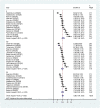In Obesity, HPA Axis Activity Does Not Increase with BMI, but Declines with Aging: A Meta-Analysis of Clinical Studies
- PMID: 27870910
- PMCID: PMC5117724
- DOI: 10.1371/journal.pone.0166842
In Obesity, HPA Axis Activity Does Not Increase with BMI, but Declines with Aging: A Meta-Analysis of Clinical Studies
Abstract
Background: Obesity is one of the major public health challenges worldwide. It involves numerous endocrine disorders as etiological factors or as complications. Previous studies strongly suggested the involvement of the hypothalamic-pituitary-adrenal (HPA) axis activity in obesity, however, to date, no consistent trend in obesity-associated alterations of the HPA axis has been identified. Aging has been demonstrated to aggravate obesity and to induce abnormalities of the HPA axis. Thus, the question arises whether obesity is correlated with peripheral indicators of HPA function in adult populations.
Objectives: We aimed to meta-analyze literature data on peripheral cortisol levels as indicators of HPA activity in obesity during aging, in order to identify possible explanations for previous contradictory findings and to suggest new approaches for future clinical studies.
Data sources: 3,596 records were identified through searching of PubMed, Embase and Cochrane Library Database. Altogether 26 articles were suitable for analyses.
Study eligibility criteria: Empirical research papers were eligible provided that they reported data of healthy adult individuals, included body mass index (BMI) and measured at least one relevant peripheral cortisol parameter (i.e., either morning blood cortisol or 24-h urinary free cortisol).
Statistical methods: We used random effect models in each of the meta-analyses calculating with the DerSimonian and Laird weighting methods. I-squared indicator and Q test were performed to assess heterogeneity. Meta-regression was applied to explore the effect of BMI and age on morning blood and urinary free cortisol levels. To assess publication bias Egger's test was used.
Results: Obesity did not show any correlation with the studied peripheral cortisol values. On the other hand, peripheral cortisol levels declined with aging within the obese, but not in the non-obese groups.
Conclusions: Our analysis demonstrated that obesity or healthy aging does not lead to enhanced HPA axis activity, peripheral cortisol levels rather decline with aging.
Conflict of interest statement
The authors have declared that no competing interests exist.
Figures






Similar articles
-
Abnormalities of the hypothalamic-pituitary-adrenal axis in nondepressed women with abdominal obesity and relations with insulin resistance: evidence for a central and a peripheral alteration.J Clin Endocrinol Metab. 2000 Nov;85(11):4093-8. doi: 10.1210/jcem.85.11.6946. J Clin Endocrinol Metab. 2000. PMID: 11095438
-
The hypothalamic-pituitary-adrenal axis activity as a predictor of cardiovascular disease, type 2 diabetes and stroke.J Intern Med. 2000 Feb;247(2):188-97. doi: 10.1046/j.1365-2796.2000.00603.x. J Intern Med. 2000. PMID: 10692081
-
Morning cortisol levels in schizophrenia and bipolar disorder: a meta-analysis.Psychoneuroendocrinology. 2014 Nov;49:187-206. doi: 10.1016/j.psyneuen.2014.07.013. Epub 2014 Jul 21. Psychoneuroendocrinology. 2014. PMID: 25108162
-
In middle-aged and old obese patients, training intervention reduces leptin level: A meta-analysis.PLoS One. 2017 Aug 15;12(8):e0182801. doi: 10.1371/journal.pone.0182801. eCollection 2017. PLoS One. 2017. PMID: 28809927 Free PMC article. Review.
-
Effects of energy restriction on activity of the hypothalamo-pituitary-adrenal axis in obese humans and rodents: implications for diet-induced changes in body composition.Horm Mol Biol Clin Investig. 2013 Sep;15(2):71-80. doi: 10.1515/hmbci-2013-0038. Horm Mol Biol Clin Investig. 2013. PMID: 25436734 Review.
Cited by
-
Links between the genetic determinants of morning plasma cortisol and body shape: a two-sample Mendelian randomisation study.Sci Rep. 2024 Feb 8;14(1):3230. doi: 10.1038/s41598-024-53727-4. Sci Rep. 2024. PMID: 38332183 Free PMC article.
-
The Impact of Obesity on the Excretion of Steroid Metabolites in Boys and Girls: A Comparison with Normal-Weight Children.Nutrients. 2023 Apr 1;15(7):1734. doi: 10.3390/nu15071734. Nutrients. 2023. PMID: 37049573 Free PMC article.
-
Association of generalized and central obesity with serum and salivary cortisol secretion patterns in the elderly: findings from the cross sectional KORA-Age study.Sci Rep. 2020 Aug 31;10(1):14321. doi: 10.1038/s41598-020-71204-6. Sci Rep. 2020. PMID: 32868802 Free PMC article.
-
Associations of age, BMI, and renal function to cortisol after dexamethasone suppression in patients with adrenal incidentalomas.Front Endocrinol (Lausanne). 2023 Jan 16;13:1055298. doi: 10.3389/fendo.2022.1055298. eCollection 2022. Front Endocrinol (Lausanne). 2023. PMID: 36760812 Free PMC article.
-
The nonhuman primate hypothalamo-pituitary-adrenal axis is an orchestrator of programming-aging interactions: role of nutrition.Nutr Rev. 2020 Dec 1;78(Suppl 2):48-61. doi: 10.1093/nutrit/nuaa018. Nutr Rev. 2020. PMID: 33196092 Free PMC article. Review.
References
-
- WHO 2015 Obesity World Health Organization (WHO). Obesity and overweight fact sheet. 2016 June [cited: 15 Junius 2016] Available: http://www.who.int/mediacentre/factsheets/fs311/en/
-
- Pelleymounter MA, Joppa M, Carmouche M, Cullen MJ, Brown B, Murphy B, et al. Role of corticotropin-releasing factor (CRF) receptors in the anorexic syndrome induced by CRF. J Pharmacol Exp Ther. 2000;293:799–806. - PubMed
-
- Rothwell NJ. Central effects of CRF on metabolism and energy balance. Neurosci Biobehav Rev. 1990;14:263–271. - PubMed
Publication types
MeSH terms
Substances
LinkOut - more resources
Full Text Sources
Other Literature Sources
Medical

